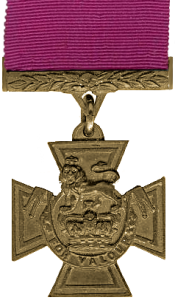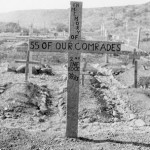7 Battalion at Lone Pine


The only one of the four infantry battalions of the 2nd Brigade (Victoria) which became heavily engaged in the Lone Pine battle was the 7th Battalion. Initially the unit, along with the 12th Battalion of the 3rd Brigade, was in close support waiting to be called if required. On the afternoon of 7 August, the bomb throwers of the 7th were called forward but the bulk of the battalion did not join the fighting until 1.30 pm on 8 August. Bean recorded that the 32 bombers sent in the previous day had by that time almost all been killed or wounded. Overall, according to the official history, the 7th Battalion suffered 354 casualties (dead and wounded) at Lone Pine and it is likely that the 7 August on the cross refers simply to the day on which the battalion began to be committed to the battle.
Corporal Alexander Burton, Corporal William Dunstan and Lieutenant Frederick Tubb
On Monday 10 August 1915, Lieutenant Frederick Tubb, 7th Battalion, waited at Anzac Cove to be evacuated wounded. He took the opportunity to write up his diary telling of what had happened at Lone Pine over the last two days. Tubb felt it would take a book to describe it all as he had, not surprisingly, kept no notes during the fighting. The 7th, Tubb, recorded, had gone into the Pine 670 strong and emerged with 320, the rest being dead or wounded. To him it seemed ‘miraculous’ that he was still alive and ‘able to write’:
Three different times I was blown yards away from bombs. Our trenches were filled with dead, mostly ours … We were glad to get out … I cannot write of details but many of our brave boys were blown to pieces. As fast as we put men in to fill the breaches they were out. I kept sending for reinforcements and bombs, all our bomb throwers were killed and so were those that volunteered to fill their places.
[Tubb diary, 10 August 1915, Stephen Snelling, VCs of the First World War: Gallipoli, 1995, p.155]

Tubb went on to name a number of men who had shown outstanding courage during the action such as Ellis, ‘killed whilst throwing back enemy bombs before they exploded’, and ‘Burton of Euroa’ who, in Tubb’s opinion, ‘deserved the highest award for his gallant action’. This ‘gallant action’ was one in which Tubb himself, although he does not mention it in his diary, had been intimately involved along with another soldier Corporal William Dunstan. The story of these three men at Lone Pine on 9 August 1915 remains unique in Australian military history for, acting together and within a short space of time, each of them showed that outstanding courage which alone attracts the award of a Victoria Cross. All three received the medal.
Source: http://www.anzacsite.gov.au/
TUBB, Lieutenant Frederick Harold 7th Australian Infantry Battalion, AIF 9 August 1915, at Lone Pine Trenches, Gallipoli Peninsular CITATION: For most conspicuous bravery and devotion to duty at Lone Pine Trenches, Gallipoli Peninsular, on 9 August, 1915. In the early morning the enemy made a determined counter-attack on the centre of the newly captured trench held by Lieutenant Tubb. They advanced up a sap and blew in a sandbag barricade, leaving only one foot of it standing, but Lieutenant Tubb led his men back, repulsed the enemy and rebuilt the barricade. Supported by strong bombing parties the enemy succeeded in twice again blowing in the barricades, but on each occasion Lieutenant Tubb, although wounded in the head and arm, held his ground with the greatest coolness and rebuilt it, and finally succeeded in maintaining his position under very heavy bomb fire. ( London Gazette 15 October 1915. )
DUNSTAN, Corporal William 7th Australian Infantry Battalion, AIF 9 August 1915, at Lone Pine Trenches, Gallipoli Peninsular CITATION: For most conspicuous bravery at Lone Pine Trenches, on the 9 August, 1915. In the early morning the enemy made a determined counter-attack on the centre of the newly captured trench held by Lieutenant Tubb, Corporals Burton, Dunstan and a few men. They advanced up a sap and blew in a sandbag barricade, leaving only one foot of it standing, but Lieutenant Tubb, with the two Corporals, repulsed the enemy and rebuilt the barricade. Supported by strong bombing parties, the enemy twice again succeeded in blowing in the barricade, but on each occasion they were repulsed and the barricade rebuilt, although Lieutenant Tubb was wounded in the head and arm and Corporal Burton was killed by a bomb whilst most gallantly building up the parapet under a hail of bombs. ( London Gazette 15 October 1915. )
For most conspicuous bravery at Lone Pine Trenches on the 9th August, 1915. In the early morning the enemy made a determined counter-attack on the centre of the newly captured trench held by Lieutenant Tubb, Corporals Burton and Dunstan and a few men. They [the enemy] advanced up a sap and blew in a sandbag barricade, leaving only one foot of it standing, but Lieutenant Tubb with the two Corporals repulsed the enemy and rebuilt the barricade. Supported by strong bombing parties the enemy twice again succeeded in blowing the barricade, but on each occasion they were repulsed and the barricade rebuilt, although Lieutenant Tubb was wounded in the head and arm and Corporal Burton was killed by a bomb while most gallantly building up the parapet under a hail of bombs. —The London Gazette, 15 October 1915[4]
Lieutenant William Symons
On the afternoon of 8 August 1915, the 7th Battalion, from Victoria, led by their commanding officer, Lieutenant-Colonel Harold Elliot, went into the Lone Pine battle to relieve the exhausted 1st and 2nd Battalions. They took over positions at the southern end of the captured Turkish trenches and here Elliott divided his command between a left and a right section. On the left he placed in charge Lieutenant William Symons. Throughout the evening and night of 8 August, Symons’ men fought a duel with groups of Turkish bombers who were able to make their way into the main trench. Eventually, the Turks were beaten back but on the morning of 9 August strong attacks were renewed against all 7th Battalion positions. At one point, it seemed that the enemy might totally engulf the southern part of the position known as Jacob’s Trench. Colonel Elliott had been impressed throughout with Symons’ leadership and consistent cheerfulness:
In this emergency, therefore, he sent for Symons, handed him his own revolver, and ordered him to retake Jacob’s Trench. ‘I don’t expect to see you again’, he said, ‘but we must not lose that post’.
[Charles Bean, The Story of Anzac, Vol II, Sydney, 1924, p.562]
The young lieutenant now led a charge down Jacob’s Trench assisted by Corporals George Ball and John Wadeson during which he killed two Turks with Elliott’s revolver. They then rebuilt a barricade but, finding themselves being attacked from three sides, Symons requested permission to withdraw to a more defensible position further back up Jacob’s Trench where there was some head cover. A few metres of open trench was thus surrendered to the Turks who now came on and managed, twice, to set fire to the head cover. Both times Symons personally charged out, beat back the attack, and extinguished the flames. Further attacks on Symons’ position were driven off by artillery fire.
For Symons’ consistent courageous leadership during this period Colonel Elliott recommended him for the VC. Like Keysor, he was evacuated from Gallipoli with enteric fever to London where, on 4 December 1915 the medal was pinned on his uniform by King George V at Buckingham Palace. On this occasion the King, so the story goes, said to Symons:
I am proud to decorate an Australian with this Cross. You may be interested to know that the intrinsic worth of this bronze cross is only five and a half pence [a few cents]. I hope you will live long enough to wear it.
[George V, quoted in Stephen Snelling, VCs of the First World War: Gallipoli, 1995, p.154]
On the 9 August 1915 during World War One, the Turks made a series of determined attacks on Jacob`s Trench at Lone Pine at Gallipoli where six Australian officers were killed or severely wounded. Learning that the position had been overrun, Lieutenant-Colonel Harold `Pompey` Elliott ordered Symons to retake the trench. Symons led the charge that drove off the Turks, but the enemy continued attacking from the front and both flanks. Symons erected a new barricade and although the Turks set fire to it, he extinguished the flames and forced the enemy to retreat. One of seven Australians to win the Victoria Cross at Lone Pine, Symons was cited for his conspicuous gallantry.

